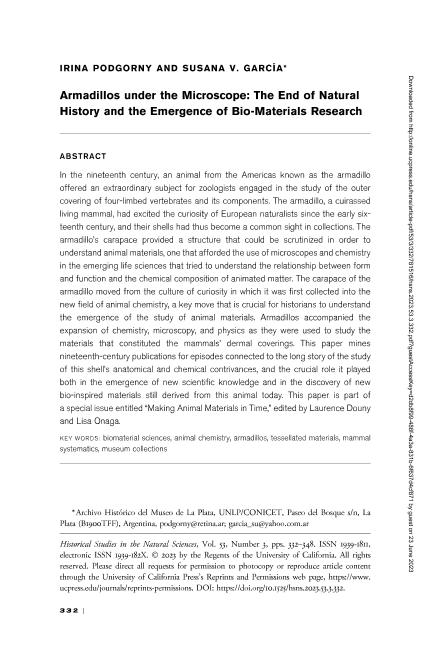Mostrar el registro sencillo del ítem
dc.contributor.author
Podgorny, Irina

dc.contributor.author
García, Susana Valeria

dc.date.available
2024-01-09T12:05:06Z
dc.date.issued
2023-06
dc.identifier.citation
Podgorny, Irina; García, Susana Valeria; Armadillos under the Microscope: The End of Natural History and the Emergence of Bio-Materials Research; Univ California Press; Historical Studies In The Natural Sciences; 53; 3; 6-2023; 332-348
dc.identifier.issn
1939-1811
dc.identifier.uri
http://hdl.handle.net/11336/222954
dc.description.abstract
In the nineteenth century, an animal from the Americas known as the armadillo offered an extraordinary subject for zoologists engaged in the study of the outer covering of four-limbed vertebrates and its components. The armadillo, a cuirassed living mammal, had excited the curiosity of European naturalists since the early sixteenth century, and their shells had thus become a common sight in collections. The armadillo’s carapace provided a structure that could be scrutinized in order to understand animal materials, one that afforded the use of microscopes and chemistry in the emerging life sciences that tried to understand the relationship between form and function and the chemical composition of animated matter. The carapace of the armadillo moved from the culture of curiosity in which it was first collected into the new field of animal chemistry, a key move that is crucial for historians to understand the emergence of the study of animal materials. Armadillos accompanied the expansion of chemistry, microscopy, and physics as they were used to study the materials that constituted the mammals’ dermal coverings. This paper mines nineteenth-century publications for episodes connected to the long story of the study of this shell’s anatomical and chemical contrivances, and the crucial role it played both in the emergence of new scientific knowledge and in the discovery of new bio-inspired materials still derived from this animal today. This paper is part of a special issue entitled “Making Animal Materials in Time,” edited by Laurence Douny and Lisa Onaga.
dc.format
application/pdf
dc.language.iso
eng
dc.publisher
Univ California Press

dc.rights
info:eu-repo/semantics/openAccess
dc.rights.uri
https://creativecommons.org/licenses/by-nc-sa/2.5/ar/
dc.subject
ANIMAL CHEMISTRY
dc.subject
ARMADILLOS
dc.subject
BIOMATERIAL SCIENCES
dc.subject
MAMMAL SYSTEMATICS
dc.subject
MUSEUM COLLECTIONS
dc.subject
TESSELLATED MATERIALS
dc.subject.classification
Historia

dc.subject.classification
Historia y Arqueología

dc.subject.classification
HUMANIDADES

dc.title
Armadillos under the Microscope: The End of Natural History and the Emergence of Bio-Materials Research
dc.type
info:eu-repo/semantics/article
dc.type
info:ar-repo/semantics/artículo
dc.type
info:eu-repo/semantics/publishedVersion
dc.date.updated
2024-01-09T10:10:33Z
dc.journal.volume
53
dc.journal.number
3
dc.journal.pagination
332-348
dc.journal.pais
Estados Unidos

dc.journal.ciudad
Berkeley
dc.description.fil
Fil: Podgorny, Irina. Universidad Nacional de La Plata. Facultad de Ciencias Naturales y Museo. Archivo Histórico; Argentina. Consejo Nacional de Investigaciones Científicas y Técnicas. Centro Científico Tecnológico Conicet - La Plata; Argentina
dc.description.fil
Fil: García, Susana Valeria. Universidad Nacional de La Plata. Facultad de Ciencias Naturales y Museo. Archivo Histórico; Argentina. Consejo Nacional de Investigaciones Científicas y Técnicas. Centro Científico Tecnológico Conicet - La Plata; Argentina
dc.journal.title
Historical Studies In The Natural Sciences

dc.relation.alternativeid
info:eu-repo/semantics/altIdentifier/doi/https://doi.org/10.1525/hsns.2023.53.3.332
dc.relation.alternativeid
info:eu-repo/semantics/altIdentifier/url/https://online.ucpress.edu/hsns/article-abstract/53/3/332/196656/Armadillos-under-the-MicroscopeThe-End-of-Natural?redirectedFrom=fulltext
Archivos asociados
